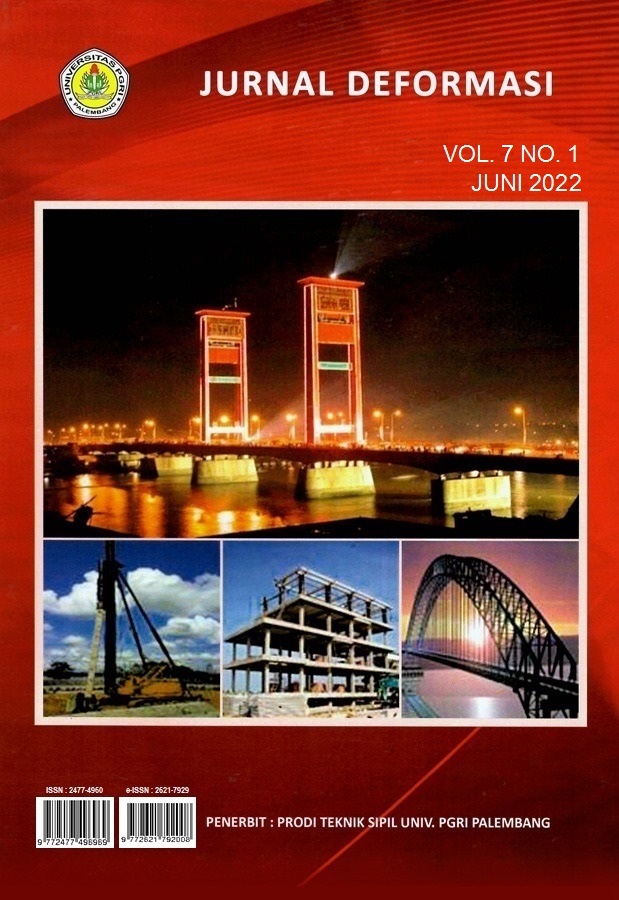Pengaruh Penggunaan Limbah Fly Ash dan Epoxy Resin Sebagai Bahan Stabilisasi Tanah Terhadap Daya Dukung Tanah di Jalan Irigas Palembang
DOI:
https://doi.org/10.31851/deformasi.v7i1.7795Keywords:
Soil Stabilization, CBR, Triaxial, Fly Ash and Epoxy Resin.Abstract
ABSTRAK
Â
Tanah merupakan bagian yang penting dalam suatu konstruksi yang mempunyai fungsi menyangga konstruksi diatasnya, bahan penyusun tanah berupa mineral dan bahan organik. Tanah dasar dapat berupa tanah asli yang dipadatkan jika tanah aslinya baik. Setiap tahunnya volume kendaraan meningkat yang akan berdampak pada kerusakan jalan Irigasi Kota Palembang. Metode penelitian ini yaitu stabilisasi kimiawi dengan cara memperbaiki kondisi tanah yang telah dicampur dengan tanah asli dan stabilizing agent berupa campuran fly ash dan epoxy resin. Salah satu solusi yang dapat diterapkan untuk mengatasi permasalahan yaitu dengan menambahkan fly ash yang didapatkan dari limbah PT.PUSRI dan campuran epoxy resin, dengan variasi penambahan fly ash 10%, 15 % dan epoxy resin 25 %. Pengujian CBR dilakukan dengan metode unsoaked. CBR unsoaked dilakukan penambahan zat aditif ke sampel tanah asli dengan persentase tanah asli 0% + fly ash + campuran epoxy resin dengan persentase penambahan sebesar 10 %, dan 15 % untuk fly ash terhadap persentase berat tanah, sedangkan untuk epoxy resin persentase penambahannya 25 % terhadap persentase berat tanah asli. Nilai CBR didapatkan bahwa penambahan fly ash 10 % dan epoxy resin 25 % merupakan nilai CBR optimum, sedangkan pada penambahan fly ash 15% dan epoxy resin 25 % mengalami penurunan nilai CBR, tetapi nilainya masih diatas nilai CBR tanah asli. Untuk hasil pengujian triaxial diketahui nilai kohesi pada STA 1 yaitu 0.197 kg/cm2, pada STA 2 yaitu 0.118. kg/cm2 dan nilai sudut geser (θ) pada STA 1 yaitu 7 dan pada STA 2 yaitu 6.
Â
Â
ABSTRACT
Â
Soil is an important has the function of supporting the construction. Every year the volume of vehicles increases which will have impacting road damage on Irigasi Street in Palembang. The method used in this study is chemical stabilization by improving the condition of the soil that has been mixed with the original soil and a stabilization in the form of a mixture of fly ash and epoxy resin. One solution that can be applied to overcome these problems is to add fly ash obtained from PT. PUSRI waste and a mixture of epoxy resin, with the addition of variations of fly ash 10%, 15%, and epoxy resin by 25%. CBR Unsoaked was done by adding additives to the soil sample with a percentage of 0% + fly ash + a mixture of epoxy resin with an addition percentage of 10% and 15% for fly ash to the percentage of soil weight, while for epoxy resin the percentage addition was 25% to percentage of soil weight The optimum CBR value can be obtained by adding 10% fly ash and 25% epoxy resin, while the addition of 15% fly ash and 25% epoxy resin will make the CBR value can decrease, but this value is still above the original soil CBR value. The results of this triaxial test can be seen from the value of cohesion at STA 1 is 0.197 kg/cm2, at STA 2 is 0.118. kg/cm2 and shear angle at STA 1 of 7° and at STA 2 of 6°.
References
AASHTO 1993, Guid for Design Of Pavement Stuctures. AASHTO, Washington, DC.
Ade Lisantono, Haryanto Yoso Wigroho, Daniel Krisna Murti, 2014. High volume fly ash as substitution of fine aggregates with the proportion of 50%, 60%, and 70% to the shear strength of reinforced concrete beams, MATEC Web of Conferences 195, 02024 (2018) https://doi.org/10.1051/matecconf/201819502024
Ani Firda, Rosmalinda Permatasari, Indra Syahrul Fuad. 2021. Pemanfaatan Limbah Batubara (Fly Ash) Sebagai MAterial Pengganti Agregat Kasar Pada Pembuatan Beton Ringan, Jurnal Deformasi Volume 6 (1),1-7.
ASTM International. Standar Test Methods for Unconsolidated-Undrained Triaxial Compression Test on Cohesive Soils ( ASTM D1883-14), United State, ASTM International.
Bowles, Joseph E. Johan K. Helnim. 2010. Sifat-sifat Fisis dan Geoteknis Tanah (Mekanika Tanah). PT. Erlangga. Jakarta.
Das, B. M. 1995. Mekanika Tanah (Prinsip-prinsip Rekayasa Geoteknis) Jilid I. PT. Erlangga. Jakarta.
Devi Oktaviana Latif, Hotma Prawoto, 2019. The Effect Of Epoxy Resin and Cement On Soil And Piile Interface Friction In Direct Shear, Universitas Gadjah Mada, Indonesia.
Denaldi Fadli, 2021. Stabilisasi Tanah Dasar Menggunakan Fly Ash Dan Epoxy Resin Terhadap Daya Dukung Tanah Di Jalan Irigasi Sematang Borang Palembang, Universitas Tridinanti, Palembang
Direktorat Jendral Bina Marga, 1997, Tata Cara Perencanaan Geometrik Jalan Antar Kota No. 038/T/BM/1997, Jakarta, Indonesia.
Doni Romadhon, 2015. Dampak Campuran Serbuk Kaca dan Serbuk Kayu Terhadap Nilai CBR Tanah Lempung, Universitas Tridinanti, Palembang.
Muhammad Zahid and Nasir Shafiq, 2020. Effects of Sand/Fly Ash and the Water/Solid Ratio onthe Mechanical Properties of Engineered Geopolymer Composite and Mix Design Optimization, Minerals, 10, 333; doi:10.3390/min10040333 www.mdpi.com /journal/minerals.
Downloads
Published
How to Cite
Issue
Section
License

Authors retain copyright and grant the journal right of first publication with the work simultaneously licensed under a Creative Commons Attribution-NonCommercial-ShareAlike 4.0 International License that allows others to share the work with an acknowledgement of the work's authorship and initial publication in this journal.



.png)
.png)


